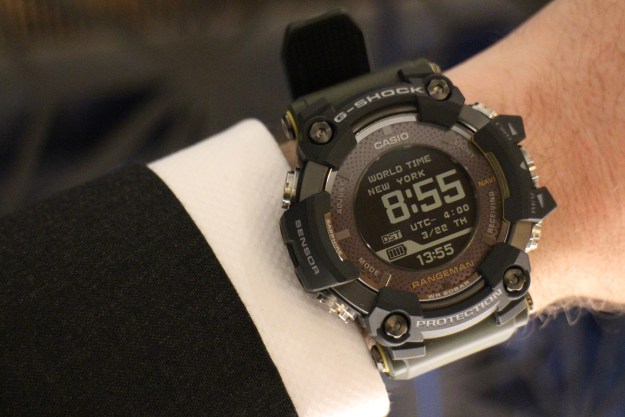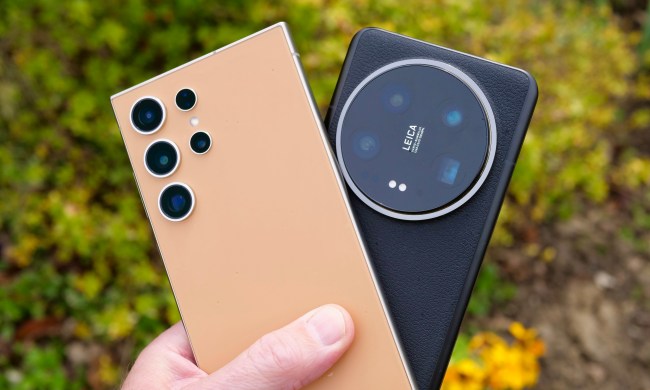
“A simple control system, solar charging, and built-in GPS make the Casio Rangeman a versatile tough watch for weekend-long trips into the wilderness.”
- The toughest watch out there
- GPS and solar charging make a great combination
- Wireless charging if needed
- Simple controls and menu system
- Cool, tough looks
- Large size makes it unsuitable for all wrists
- Expensive
Casio continues to do things differently with its connected watches. For the G-Shock range, the company hasn’t adopted touchscreens, preferring to augment its Master of G series watches with smart features relevant to the series theme. We recently looked at the GPW-2000 Gravitymaster and its flight-oriented smart features, and now we’re checking out the GPR-B1000 Rangeman — aimed at the outdoorsman who enjoys nothing more than getting completely lost over a weekend. The Rangeman will help you find where you’re going when Google Maps won’t quite do.
Built like a tank
First, let’s talk about the size. This is a typical Master of G G-Shock watch, in that it has a 60mm case, weighs 142 grams, and is big, bold, and built like a tank. This isn’t a watch for the meek. While purposeful, it’s easy to fall for the GPR-B1000 because it’s the best looking Rangeman yet, closely resembling Casio’s Mudmaster series.
Aimed at the outdoorsman who enjoys nothing more than getting completely lost over a weekend.
It’s also tough like the Mudmaster. Dust, dirt, shock, high and low temperatures, mud, and water pose no issue to the Rangeman, which also has a sapphire crystal over the face for extra damage protection. Even the strap is reinforced by carbon fiber, and the case back is 2.3mm thick ceramic. You’re not going to break this watch.
It’s not as heavy as it sounds, either. It’s large, and won’t fit under a shirt sleeve; but the underside of the strap curves around your wrist making it surprisingly comfortable. G-Shock watches are also made to be worn loose, not tight against your arm. Do this, and they’re manageable even day-to-day. The fully digital display is easy to read, and the backlight is bright and clear enough to illuminate the screen evenly. It’s not a massive screen though, and it may take some time to understand and learn some of the smaller details before you rely on them at a glance.
Tracking your path
The 2018 Rangeman is the first solar-charged G-Shock watch with GPS, but it’s not meant to navigate you to work and back. It’s meant to get you from point A to point B, and it does this on the screen with directional guidance, based on mapping on the G-Shock app. The built-in GPS tracks the watch, so it doesn’t drain the battery on your phone, while routes and waypoints are created in the app. The data syncs between the two using Bluetooth. Additionally, your adventures are tracked and can be viewed as a timeline or on a 3D map.
Because the Rangeman doesn’t have a touchscreen, you control the watch via the various buttons on the body. Casio’s history here isn’t that good, as some of its older models are a little confusing to use. Things are better here on the Rangeman. You can access modes and features using the two buttons on the left, and navigate and select them using the crown on the right. It’s simple, clear, and quick to learn. The buttons are large enough to press wearing thin gloves, but twisting the crown — accurately, at least — may not be possible.
The 2018 Rangeman is the first solar-charged G-Shock watch with GPS.
We like the customizable main screen, which can show everything from barometric pressure, sunrise and sunset times, and world times, to GPS waypoint data. You can quickly select these options using the basic menu structure. The Rangeman is meant to simplify GPS navigation out in the wild, or where there are no street names. Doing so by utilizing a complicated menu would be a shame, but Casio has done a good job on the GPR-B1000’s ease of use.
The companion app is similar to the one we used with the Gravitymaster. It’s visually attractive, and all the main features of the watch, like alarms and world time, can be set up through it. We connected the watch a few times to an iPhone and had no issues, but the data connection was a problem during our test, so we were unable to use the maps. We were also indoors, which didn’t help the GPS find its position.
Solar power
How about the battery? The Rangeman has solar power, meaning that if the watch is out in the light, it’s constantly being charged. If it has been starved of light long enough that the battery has drained completely, Casio supplies a wireless charging plinth that takes the battery to full in five hours, enough for 33 hours of continuous GPS use.
There’s no doubt that the Rangeman’s features will appeal to a niche audience; but it’s easily the most practical out of all the Master of G watches. The Gravitymaster’s connected features primarily appeal to pilots, and we feel the Rangeman’s GPS will appeal to a wider audience. Land Rover is exploring the same interest in outdoor pursuits with its Explore smartphone. The rugged, but still very cool design, helps the GPR-B1000; and the toughness, along with solar charging, means the watch will last for many years to come.
It’s not cheap, though, at $800, which is the case for all the Master of G G-Shock watches. We really liked the Rangeman and felt that unlike the Gravitymaster, even those wearing it for its style may get use out of the wider connected features at some point.
The GPR-B1000 Rangeman is now available for purchase online via Amazon or any other participating dealer.
Updated 6/14/18: Casio’s G-Shock Rangeman is now available for purchase.








